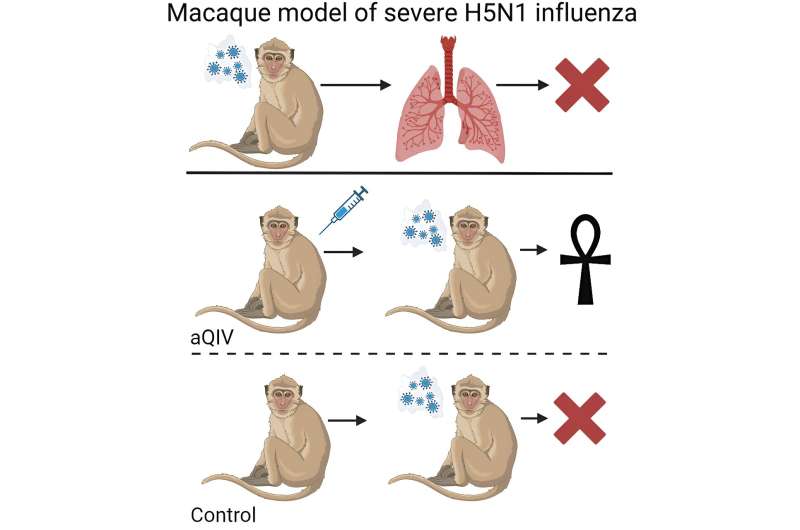This article has been reviewed according to Science X's editorial process and policies. Editors have highlighted the following attributes while ensuring the content's credibility:
fact-checked
peer-reviewed publication
trusted source
proofread
Preparing for the next pandemic: Study offers improved method for tackling bird flu

Researchers from the University of Pittsburgh and the National Institutes of Health (NIH) Vaccine Research Center have developed an improved way to test potential vaccines against bird flu. The report was published this week in the journal iScience.
Concerning reports about avian flu outbreaks at poultry facilities across the country and abroad highlight the increasingly urgent need for a safe and effective vaccine that could thwart a possible spread of the virus from human to human. To be ready to safely and efficiently test promising vaccine candidates, researchers developed an animal model that more closely mimics the typical symptoms of human infection than any such model so far. This proactive work minimizes the steps needed to quickly validate and deploy a new vaccine in a crisis.
"The COVID-19 pandemic got people to realize that it is not enough to respond to a pandemic when it happens. We really need to make sure that we are ready before it is here," said co-senior author Doug Reed, Ph.D., associate professor of immunology at Pitt's Center for Vaccine Research.
Bird flu, caused by H5N1 influenza virus, is primarily spread by migratory wild birds and can decimate poultry populations, including chickens and ducks. Although the virus has infected people, previous infections have not spread efficiently from human to human. However, there are documented cases of H5N1 spreading in mammalian populations, ranging from minks to sea lions and dolphins, raising concern about human-to-human spread.
People infected with H5N1 virus can develop acute respiratory distress syndrome, or ARDS, manifesting in short and labored breathing. H5N1 kills more than half of those infected.
To ensure that a future vaccine will be protective, the researchers turned to macaques, which have close anatomy and physiology to humans, making them a choice model for the testing of life-saving medicines.
Reed and his coauthor, Simon Barratt-Boyes, Ph.D., professor of infectious diseases and microbiology at the Pitt School of Public Health, reasoned that delivering H5N1 virus by small particle aerosol would make it more likely to reach deep into the lung and mimic natural exposure.
They first demonstrated this aerosolized infection model in research published in 2017. In the new paper, they refined their model and evaluated whether a seasonal flu vaccine, which protects against human influenza A and B viruses, when given three times with an experimental adjuvant could prevent ARDS upon exposure to aerosolized H5N1 virus.
All monkeys that received adjuvanted seasonal flu vaccine were protected from death, and there were low but measurable neutralizing antibodies against H5N1 in their blood samples, the quantity of which was inversely correlated with the severity of their symptoms.
While the researchers caution that their findings do not mean that a seasonal flu vaccine can efficiently protect against bird flu, they are optimistic that protective efficacy of future vaccines that target H5N1 can be tested using this model and deployed faster.
"The original idea behind this work was more than 20 years in the making," said Reed. "Now there is a path forward to get people protected against this devastating disease."
More information: Masaru Kanekiyo et al, Refined semi-lethal aerosol H5N1 influenza model in cynomolgus macaques for evaluation of medical countermeasures, iScience (2023). DOI: 10.1016/j.isci.2023.107830





















